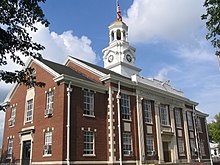George D. Waller
George D. Waller | |
|---|---|
| Born | 1883 Nashville, Tennessee, U.S. |
| Died | December 19, 1969 (aged 85–86) Nashville, Tennessee, U.S. |
| Resting place | Mount Olivet Cemetery |
| Occupation | Architect |
| Spouse | Julia Aubie Lasley |
| Children | 2 sons |
George D. Waller (1883 – December 19, 1969) was an American architect from Tennessee who designed churches, schools, houses and courthouses, some of which are listed on the National Register of Historic Places.
Early life
[edit]Waller was born in 1883 in Nashville, Tennessee.[1]
Career
[edit]Waller began his architectural career supervising the design of Hume-Fogg High School in 1912.[1][2] In 1922, he received the first "architect's license in the state of Tennessee."[1] He also joined the American Institute of Architects and its Tennessee chapter.[2]


Waller designed various schools in Tennessee, Kentucky, Alabama, and Georgia.[2] He also designed churches like the Belmont United Methodist Church, the Meridian Street United Methodist Church, and the Waverly Place United Methodist Church.[1] He also designed Haynes Haven Farm in Spring Hill,[1] now a training center for General Motors.
Waller designed at least two buildings listed on the National Register of Historic Places: Stone Hall in Nashville and the Cannon County Courthouse in Woodbury.[2] His own house, located at 2527 West Ashwood Avenue, is listed as a contributing property to the Hillsboro-West End Historic District.[3]
In the words of Christine Kreyling, Waller was “one of the last of Nashville’s architects with a thorough grasp of the ethos of the Grecian style.”[2]
Personal life and death
[edit]Waller married Julia Aubie Lasley.[1] They had two sons, Louis and Raymond.[1] He attended the Belmont United Methodist Church.[1]
Waller died on December 19, 1969, in Nashville.[1] He was buried in Mount Olivet Cemetery.[1]
References
[edit]- ^ a b c d e f g h i j "George Waller Rites Tomorrow". The Tennessean. December 20, 1969. p. 21. Retrieved December 29, 2017 – via Newspapers.com.
- ^ a b c d e "Stone Hall History" (PDF). nashville.gov.in. Retrieved 12 January 2016.
- ^ Mark Sturtevant; Philip Thomason; Timothy Netsch (May 10, 1993). "National Register of Historic Places Registration: Hillsboro-West End Historic District". National Park Service. United States Department of the Interior. Retrieved December 29, 2017.
